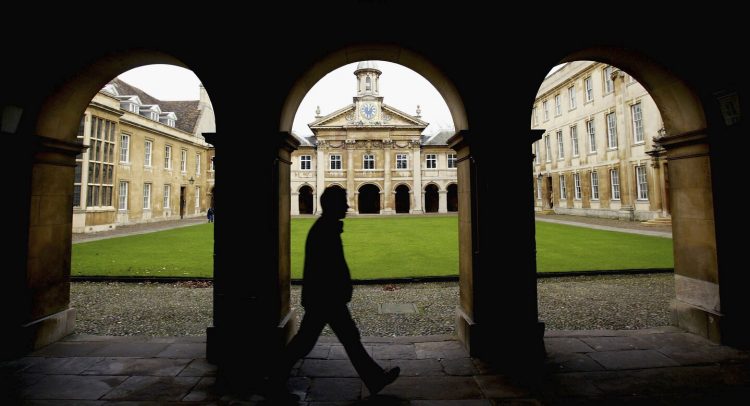Comment on this story
Comment
LONDON — Britain’s prestigious University of Cambridge has opened an inquiry after several student deaths have been reported in recent months, as the student union warns of a growing mental health crisis.
The leafy university, about 60 miles northeast of London, has reported five student deaths between March and June this year. The university says one has been “confirmed as suicide,” while the other four are suspected suicides awaiting investigation by the coroner.
The university’s Vice Chancellor Stephen Toope said he was “deeply saddened” by the deaths in a statement on Tuesday. “At this distressing time, our community’s thoughts remain with the families and friends of the students who have died.”
He said the safety of students is “of fundamental importance” and that the university was working to “review these tragic events” and put in place plans to support mental health and well-being.
Founded in 1209, Cambridge has more than 20,000 students and is a global academic institution. It boasts more than 121 Nobel Prize laureates and 47 heads of state among its alumni and affiliates.
In a separate statement a day earlier, Cambridge said it had set up a “rapid Incident Response Group,” — a separate inquiry from the coroner’s investigation — in coordination with public health officials and local suicide prevention groups, to review the deaths.
For the first four deaths, the group found that “no common cause or clear linkages were evident,” the university said. It is still reviewing the fifth death.
“We are shocked and deeply saddened by the tragic deaths,” said Graham Virgo, senior pro-vice-chancellor in a statement on Monday. “All of these students were valued members of our community,” he added, noting that the school was “in contact with the parents of those students who have died to support them at this extremely difficult time.”
However, the university’s own student union, an elected body that represents students, issued a statement in response to the deaths casting blame on some of the university’s policies.
“It’s wrong to speculate on the circumstances surrounding each student’s death, but we should not shy away from the fact that there is a student mental health crisis at Cambridge,” it said.
It called the number of deaths “troubling” and said it felt obliged to take a public stand “against the series of failures that we have witnessed in the University and across the colleges.”
The deaths took place at different colleges within the university, which is made up of 31 constituent colleges.
The Student Union accused a university-wide suicide prevention strategy of being “shamefully unambitious” and “diluted beyond recognition,” labeling it a “dereliction of duty.” It called on school leaders to “urgently review” suicide safety strategies and commit to a preventive approach.
The university did not comment on the explicit accusations but pointed The Washington Post to Toope’s statement on the work being done to support student well-being.
It said it was investing about $6 million a year on an action plan to support mental health including a new student support division, student well-being advisers, cutting mental health help wait times, and training in suicide awareness for front line staff.
“Nothing is more important than the safety of our students,” it said in Monday’s statement. “Sadly, across universities here in the UK, and internationally, we are seeing growing numbers of young people using counseling services and reporting struggles with their mental health.”
Despite the concern over the recent deaths, public health experts have emphasized that overall, suicide rates for college students in both the U.K. and United States have been trending downward in recent years. The most recent data from Britain’s Office for National Statistics found suicide rates for higher education students in the academic year ending 2020 was three deaths per 100,000 students — the “lowest rate observed over the last four years.”
In the U.S. too, suicide rates are also generally falling for almost all demographic groups, according to the American Association of Suicidology, although suicide still ranks as the second leading cause of death for 15- to 24-year-olds.
However, the coronavirus pandemic and cost of living crisis are recent factors that public health experts say have led to an increase of mental health issues among students.
Steve West, president of Universities UK, a membership body that represents 140 universities across the country, said there had been a rise in mental health issues reported across student populations in the United Kingdom.
“Universities should be safe and mentally healthy places to live, work and study,” he said in an email to The Post, “every life lost through suicide is a tragedy.”
“Whilst there is no evidence that overall numbers of student deaths by suicide are increasing, risk factors such as self-harm, depression, debt, disengagement and loneliness mean that universities need to be vigilant to spot the signs and respond quickly.”
A spokesperson from the National Union of Students, a confederation of nearly 600 students’ unions representing 7 million students, told The Post they were “shocked and saddened to hear of cases of student suicide,” which showed “universities are not separate from wider society.”
“Our research has shown that students are overwhelmingly burdened by anxieties, often rooted in poverty and academic pressure — and now sadly exacerbated by the cost of living crisis,” the NUS said.
Pressures on students globally has been exacerbated by the coronavirus pandemic as they have weathered shifting academic schedules, online learning, mask protocols and restrictions on socializing.
Data from a 2021 Healthy Minds Network Study showed 34 percent of American college respondents had anxiety disorder and 41 percent had depression — rates that have risen in recent years. More broadly, nearly 73 percent in the Fall 2021 American College Health Association National College Health Assessment survey reported moderate or serious psychological distress.
“There’s no doubt that young people are under considerable pressure out there at the moment,” said Ged Flynn, chief executive of Papyrus, a British charity that works to prevent young suicide.
There was some “good news,” he added, with national data trends showing that overall suicide rates had stayed the same or dropped in recent years. However, he added, this was not the case for 11- to 19-year-olds, an age group presenting the “biggest worry.”
Flynn said academic institutions should do more to reach this age cohort and “make it clear they’re not on their own.” He added, “we firmly believe that many suicides can be prevented and we want there to be positive outcomes.”
If you or someone you know needs help, call the National Suicide Prevention Lifeline at 800-273-TALK (8255) or visit suicidepreventionlifeline.org. You can also text a crisis counselor by messaging the Crisis Text Line at 741741
Source by www.washingtonpost.com





























